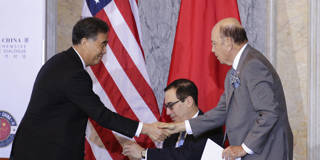The cost to US consumers and firms imposed by tariffs on Chinese imports is not large relative to the gain that would be achieved if the US succeeds in persuading China to stop illegally taking US firms’ technology. But the Trump administration should state that this is the goal, and that the tariffs will be removed when it is met.
CAMBRIDGE – The most frequent questions that I get when I speak to non-economists concern the tariffs that the United States is levying on imports from China. Why is President Donald Trump’s administration doing this? Aren’t the tariffs a tax on the goods purchased by American consumers? Why does Trump think the US can “win” a trade war with China? How do the Chinese respond to the current tariffs and threats of more? And so on.
I usually start my answer by stressing that, like almost all economists, I oppose tariffs in general. I, too, prefer an environment in which governments do not interfere with imports and exports, and in which US firms can operate freely in foreign countries.
I acknowledge that we have an enormous trade deficit with the rest of the world (about $800 billion this year, or 4% of US GDP) and that our trade deficit with China is about half of that total (about $400 billion). But I always emphasize that our overall trade deficit reflects the fact that the US spends more than it produces, requiring us to obtain the difference through net imports.

CAMBRIDGE – The most frequent questions that I get when I speak to non-economists concern the tariffs that the United States is levying on imports from China. Why is President Donald Trump’s administration doing this? Aren’t the tariffs a tax on the goods purchased by American consumers? Why does Trump think the US can “win” a trade war with China? How do the Chinese respond to the current tariffs and threats of more? And so on.
I usually start my answer by stressing that, like almost all economists, I oppose tariffs in general. I, too, prefer an environment in which governments do not interfere with imports and exports, and in which US firms can operate freely in foreign countries.
I acknowledge that we have an enormous trade deficit with the rest of the world (about $800 billion this year, or 4% of US GDP) and that our trade deficit with China is about half of that total (about $400 billion). But I always emphasize that our overall trade deficit reflects the fact that the US spends more than it produces, requiring us to obtain the difference through net imports.